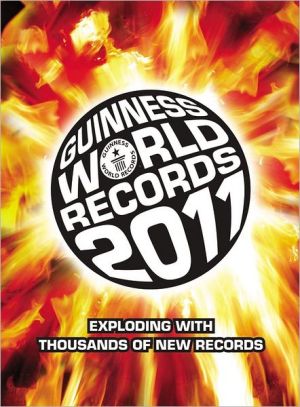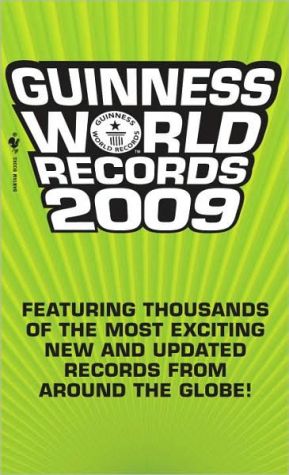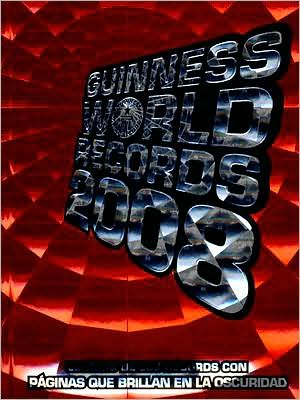Guinness World Records 2010: Thousands of new records in The Book of the Decade!
From the most searched-for person on the Internet to the youngest billionaire, from the shortest film title to the longest nose—if a world record has been created or surpassed, it’s here!\ \ Guinness World Records™ 2010 gathers the most remarkable, inspirational, and wacky record breakers yet from every corner of the globe—and even beyond the solar system. Filled with don’t-try-this-at-home human achievements, natural and technological wonders, incredible feats in sports and...
Search in google:
From the most searched-for person on the Internet to the youngest billionaire, from the shortest film title to the longest nose—if a world record has been created or surpassed, it’s here! Guinness World Records™ 2010 gathers the most remarkable, inspirational, and wacky record breakers yet from every corner of the globe—and even beyond the solar system. Filled with don’t-try-this-at-home human achievements, natural and technological wonders, incredible feats in sports and entertainment, and much more, this updated edition introduces exciting new records and unbelievable facts that will captivate the imagination. Did you know . . . • To celebrate the launch of its new route from Dubai, UAE, to Sao Paulo, Brazil, the Emirates airline aired a TV commercial that was 14 hours and 40 minutes long—the same length as the journey itself?• The deadliest mountain of them all is Annapurna I, where 41 percent of climbers die striving for the peak?• The Detroit Lions hold the record for most losses in an NFL season, ending the 2008 season with a 0–16 record? And that’s just a hint of what you’ll find inside this amazing book, including striking all-new photos and new sections on seemingly unbreakable records, unusual rituals from around the globe and other wild events celebrating the first decade of the twenty-first century—plus information on how you too can join the Guinness World Records family, and offers on free downloadable content, from videos to wallpapers.
Chapter One\ SPACE\ CONTENTS\ DEEP SPACE 3\ EXTRA-SOLAR PLANETS 9\ EXPLORING THE SOLAR SYSTEM 12\ MARS 16\ DEEP SPACE\ HOldest brown dwarf Brown dwarfs are "failed stars," much like gas supergiants that never became large enough to produce the internal pressures necessary for nuclear fusion. One brown dwarf in the sparse halo surrounding our galaxy (the Milky Way) is 2MASS 1626+3925. Measurements of the weak infrared light it emits suggest that this failed star is around 10 billion years old: more than twice as old as our Solar System.\ HShortest distance between two black holes In March 2009, astronomers reported that the quasar (short for "quasi-stellar object") SDSS J153636.22+044127.0, a galaxy emitting vast quantities of electromagnetic energy, appears to contain two black holes (a binary black hole) at its center. The black holes weigh the equivalent of around 50 million and 20 million Suns, respectively, yet are separated by only one-third of a light-year.\ HDensest galaxies Ultra Compact Dwarf (UCD) galaxies are a class of galaxy discovered in 1999 by a team of astrophysicists led by Dr. Michael Drinkwater (Australia). Dozens of UCD galaxies, which are possibly leftover building blocks that once formed much larger galaxies, are now known to astronomers. These small galaxies contain around a hundred million stars in a space just 200 light-years across, but astronomers suggest that billions of years ago these galaxies had a density of perhaps one million stars per cubic light year-one million times higher than the density of the Milky Way.\ HGalaxy with the highest level of star formation Astronomers studying the light from the galaxy J1148+5251 have estimated that stars are being formed there at a rate of around 1,000 solar masses per year- roughly a thousand times greater than the rate of star formation in our own galaxy. J1148+5251 is a distant active galaxy known as a quasar. At 12.8 billion light years away, astronomers are watching its star-forming activity as it was 12.8 billion years ago.\ HFastest approaching galaxy Despite the overall expansion of the Universe, there are only a small number of galaxies that are approaching our own. M86, a lenticular (lens-shaped) galaxy around 52 million light years away in the Virgo Cluster, is moving toward the Milky Way at 260 miles/s (419 km/s).\ IHeaviest black hole In February 2008, astronomers announced their discovery of a black hole in the dwarf galaxy IC 10, which has a mass estimated to be as much as 33 times that of the Sun. With the exception of the supermassive class of black holes at the heart of galaxies, this is more than double the size of any known black hole.\ Nearest pulsar Pulsars are a type of neutron star that emit beams of radiation as they rotate. They are formed in supernova explosions where protons and electrons in the atoms of a star's core are fused together into neutrons. Since neutrons comprise much of an atom's mass, neutron stars are small and dense, usually the size of a large city, but containing as much mass as the Sun. Pulsar PSRJ0108-1431, in the constellation of Cetus, is just 280 light-years away from the Earth.\ IMost distant object in the universe On April 23, 2009, NASA's Swift satellite detected a 10-second-long gamma-ray burst and its subsequent X-ray afterglow eminating from star GRB 090423. Later analysis revealed GRB 090423 to be roughly 13.035 billion light-years away, which means the explosion occurred close to when the Universe is estimated to have formed (see page 7). This also makes GRB 090423 the Holdest object in the Universe yet detected.\ EXTRASOLAR PLANETS\ ILightest extrasolar planet Gliese 581e, whose discovery was announced in April 2009, is the fourth planet discovered to date orbiting the star Gliese 581. Estimates of its properties reveal that it could have the same mass as just 1.9 Earths; however, this rocky planet orbits too close to its star to have conditions suitable for life.\ Generally, extrasolar planets are named after the star they orbit in the order that they are discovered. ("A" is not used as it refers to the star itself.) So, the first planet detected orbiting Gliese 581 is Gliese 581b, and so forth. There are many ways of naming stars, but the system of adding a letter at the end to denote objects in the orbit is standard.\ HMost elongated extrasolar planet orbit HD 80606b, the first extrasolar planet on which real-time weather changes have been observed (see below), is 190 light years away in the constellation Ursa Major. It has a highly elliptical (oval-shaped) orbit, similar to that of a short period comet. During each orbit, the planet ranges in distance from its star from just 2.8 million miles (4.5 million km) at its closest point to 78 million miles (125 million km) at its most distant point. HD 80606b's solar year-that is, the time it takes the planet to orbit its star-lasts a mere 111 days.\ HHottest extrasolar planet HD 149026b is a gas giant orbiting a yellow sub-giant star 257 light years away. Orbiting close to its parent star, it achieves a temperature of around 3,7048F (2,0408C), well above the melting point of iron. The planet is probably metal- rich and very dark and likely to have dark clouds of metal oxides that absorb the star's radiation efficiently, contributing to its immensely high temperature.\ Oldest extrasolar planet The oldest planet yet discovered is an extrasolar planet in the globular cluster M4, some 5,600 light-years from Earth. With an estimated age of at least 10 billion years, this distant planet is more than twice as old as our Solar System. Its discovery was announced in July 2003.\ HLargest star with a planet In January 2003, astronomers announced their discovery of a planet orbiting the orange giant star HD 47536. This star is expanding at the end of its life and currently measures around 20 million miles (33 million km) across. HD 47536b, one of two planets spotted in the system, is 186 million miles (300 million km) from its star but will eventually be consumed in a few tens of millions of years as the star continues to expand into a red giant.\ HFirst map of an extrasolar planet In 2007, NASA's Spitzer infrared space telescope was pointed at the star HD 189733, and its accompanying planet, HD 189733b, and observed the system for 33 hours. The resulting observations were converted into a temperature map showing a range from 1,292 to 1,7248F (700 to 9408C). The planet was discovered by the transit method, in which the planet passes between the Earth and the planet's star, reducing the light visible from the star by 3%.\ HColdest extrasolar planet OGLE-2005-BLG-390Lb, named in part from the Optical Gravitational Lensing Experiment (OGLE) observatory that played a role in its discovery in 2006, orbits a cool red dwarf star 21,000 light-years from Earth. The low energy of its star coupled with the size of its orbit, farther out from its star than Mars is from our Sun, means its surface temperature is just -3648F (-2208C). Its mass is estimated at around five times that of Earth's and it probably has an icy surface, rocky core, and thin atmosphere.\ HWindiest exoplanets HD179949b, HD209458b, and 51 Pegasi b are all gas giants orbiting different stars within 150 light years of Earth. Each orbits its star within around 4.5 million miles (8 million km)- far closer than Mercury orbits the Sun. Results released in January 2007 show that the temperature difference between day and night on these planets is tiny. To explain this, some scientists suggest that supersonic winds of up to 9,000 mph (14,500 km/h) are constantly transferring heat from the planets' day sides to their night sides.\ First detection of an exoplanet atmosphere In November 2001, astronomers used the Hubble Space Telescope to detect light passing through the atmosphere at the edge of the planet HD 209458b as it passed in front of its star. Spectral analysis of this light revealed the presence of sodium in the atmosphere of this scorched gas giant, which orbits its star in just 3.5 days. Subsequent observations of this planet have suggested the presence of water vapor in its atmosphere.\ EXPLORING THE SOLAR SYSTEM\ HFirst thunder heard on another planet The USSR's Venera 11 lander touched down on Venus on December 25, 1978. Among its instruments was an acoustic detector capable of registering sound in the Venusian sky and on its surface. During its parachute descent the detector heard the sound of the wind, and it picked up the noises of the lander's other equipment operating just after touchdown. Roughly 32 minutes after landing, another sound of unknown origin with a level of 82 decibels was detected. A Venusian thunder clap is the most likely explanation.\ HFirst mission to study a dwarf planet NASA's Dawn spacecraft was launched on September 27, 2007. Its goal is to reach the asteroid Vesta in the asteroid belt between Mars and Jupiter, study it from orbit, and then break orbit to rendezvous with Ceres, the largest object in the asteroid belt. Ceres, like Pluto, was reclassified as a dwarf planet in 2006. Despite launching later than NASA had hoped, Dawn will reach Ceres in February 2015, five months before the New Horizons spacecraft reaches Pluto.\ HMost distant planet studied from orbit The exploration of the Solar System by unmanned spacecraft began with simple fly-by missions, in which a probe would hurtle past a planet, gathering data. Fly-bys are eventually followed by orbiter missions: as their name suggests, a spacecraft collects planetary data while in orbit. In July 2004, upon the arrival of NASA's Cassini orbiter, Saturn (on average 888 million miles; 1.43 billion km from the Sun) became the most distant planet to be studied from orbit.\ Fastest departure speed from Earth The fastest speed at which a spacecraft has ever departed from Earth is 36,250 mph (58,338 km/h). It was achieved by NASA's New Horizons spacecraft, which launched from Cape Canaveral on January 19, 2006, beginning a nine-year flight to Pluto and its moons Charon, Nix, and Hydra.\ ILargest space station The International Space Station (ISS) has been under construction since its first component, the Zarya module, was launched in November 1998. On May 31, 2008, NASA astronauts attached the Kibo module, made by the Japan Aerospace Exploration Agency (JAXA), bringing the total mass of the ISS so far to 657,000 lb. (298,000 kg).\ Longest comet tail (measured) The longest comet tail ever measured was 350 million miles (570 million km) long and belonged to the comet Hyakutake. This is more than three times the distance from the Earth to the Sun. The tail was discovered by Geraint Jones of Imperial College, London, UK, on September 13, 1999, using data gathered by the ESA/NASA spacecraft Ulysses-on a chance encounter with the comet on May 1, 1996. Although other comets undoubtedly have longer tails, this is the longest ever measured.\ SPACE TOURISTS\ Businessman Dennis Tito (U.S.A.) became the first space tourist, flying to the International Space Station on a trip that lasted from April 28 to May 6, 2001.\ Anousheh Ansari (Iran) became the first female space tourist on September 18, 2006, with a 10-day visit to the International Space Station.\ The Hmost prolific space tourist is Charles Simonyi (U.S.A.), who has successfully completed two trips into space. Simonyi departed on his first expedition on April 7, 2007, and his second on March 26, 2009.\ MARS\ ILongest time survived on Mars by a rover The twin Mars Exploration Rovers, Spirit ± and Opportunity ∞ (the largest planetary rovers), touched down successfully on the surface of Mars on January 4 and 25, 2004, respectively. Since then, they have each traveled across the Martian surface taking scientific images and measurements. By April 2009, the Opportunity rover had traveled 51,853 ft. (15,805 m) over the surface-far farther than it had been originally designed for. As of May 2009, both rovers are still operational.\ Largest impact crater One of Mars' most striking features is the stark difference between the low-lying plains of its northern hemisphere and the ancient cratered highlands of its southern hemisphere. Analysis of data from NASA's orbiting probes suggests the whole northern hemisphere could be a vast impact basin 5,300 miles (8,500 km) across-significantly lower than the southern hemisphere. This impact would have happened more than 3.9 billion years ago and would have required an object larger than the dwarf planet Pluto to create.\ HMost recent evidence of water on Mars An image taken by Mars Reconnaissance Orbiter of a dry gully in the Promethei Highlands suggests liquid water flowed on Mars as recently as 1.25 million years ago. The gully looks like it formed as ice melted, flowed downhill, and deposited sediment before evaporating in the thin Martian atmosphere.\ HFirst successful polar lander NASA's Phoenix spacecraft ≠ landed in the Vastitas Borealis, the great world-wrapping lowland plain of the northern polar region, on May 25, 2008. It entered the atmosphere after a nearly nine-month journey at 13,000 mph (21,000 km/h), using a heat shield, then parachute and retro rockets to slow to just 4.9 mph (8 km/h) for touchdown. Contact was lost with Phoenix on November 2, 2008.\ Largest canyon in the solar system The Valles Marineris Æ on Mars is the largest canyon in the Solar System. It has an overall length of about 2,800 miles (4,500 km). At its widest, it is 370 miles (600 km) across and is also up to 4.3 miles (7 km) deep. It is named after the Mariner 9 spacecraft that first discovered it in 1971.\ HMost spacecraft orbiting the same planet When NASA's Mars Reconnaissance Orbiter entered Martian orbit in March 2006, there were three other functioning spacecraft orbiting the red planet: Mars Global Surveyor, Mars Odyssey, and Mars Express. In addition, there were two rovers operating on the planet's surface, making the total number of active spacecraft exploring the same planet six.\ HFirst Martian aurora In June 2006, ESA announced that its Mars Express Orbiter had detected localized aurorae on Mars. On Earth, the northern and southern lights are caused by charged particles from the Sun interacting with the planet's magnetic field, making parts of the upper atmosphere glow like a neon tube. Mars has no magnetic field; instead, its aurorae are caused by the solar particles interacting with regions of locally magnetized rock-remnants from when Mars had a magnetic field of its own.\ Most enduring orbiter NASA's Mars Global Surveyor was launched in 1996 and entered Martian orbit on September 11, 1997. It was due to spend just two years mapping and monitoring the planet but, because of the success of the mission and the quality of its science, it was granted multiple extensions.\ Contact was lost with the spacecraft on November 2, 2006-by which time it had sent more than 250,000 images of the red planet back to Earth after more than nine years in orbit.







